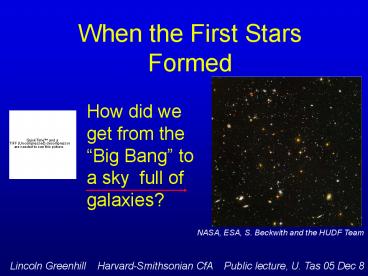When the First Stars Formed - PowerPoint PPT Presentation
Title:
When the First Stars Formed
Description:
z=20. Springel & Hernquist 2003 (Gnedin et al.) Increasing transparency ... Yes or no, it will be one of the great challenges of astronomy and an adventure. ... – PowerPoint PPT presentation
Number of Views:40
Avg rating:3.0/5.0
Title: When the First Stars Formed
1
When the First Stars Formed
How did we get from the Big Bang to a sky full
of galaxies?
NASA, ESA, S. Beckwith and the HUDF Team
Lincoln Greenhill Harvard-Smithsonian CfA
Public lecture, U. Tas 05 Dec 8
2
Is this as far back in time as we can see?
What came before these galaxies?
3
Before the first galaxies
Fireball of birth and a hot soup of radiation
and matter
4
Temperature History
Radiation
Temperature
Matter
z
104
103
Time
300,000 yr
5
Temperature History
Radiation
Temperature
Matter
103 K
Hydrogren Recombination
z
104
103
Time
300,000 yr
6
Temperature History
Radiation
Temperature
Matter
103 K
Last scattering of radiation by matter Matter
and primeval radiation go separate ways
z
104
103
Time
300,000 yr
7
Structure at Recombination
DT/T10-5
Very uniform!
NASA/GSFC/WMAP Collab.
Background microwave emission remnant
8
Structure at Recombination
NASA/GSFC/WMAP Collab.
DT/T10-5
A far cry from stars and galaxies
Background microwave emission remnant
9
Temperature History
Radiation
Temperature
Matter
103 K
The Dark Ages (a sea of H)
z
104
103
Time
0 yr
300,000 yr
10
A Very Different Place when the First Stars
The Dark Ages
First Luminous Objects
z
103
101
6.2
300,000 yr
0 yr
109 yr
Collapse of dark matter and cold Baryonic matter
11
Ecology at Recombination
Matter 13 normal 87 dark on avg.
Most matter in the universe appears to be DARK,
apparently interacting only via gravity (Zwicky
c.1933) Dark/normal matter are intermingled.
Collapse of dark matter structures carries along
normal matter.
Baryogenesis
http//aether.lbl.gov/WWW/tour/elements/early/earl
y_a.html
12
Collapse of Dark Matter during Reionization (Sprin
gel et al. 2005)
13
Collapse of baryonic matter into stars and
galaxies
z20
Time
Springel Hernquist 2003
14
(Gnedin et al.)
15
Increasing transparency during reionization (Gnedi
n et al.)
16
How Can We Study the EOR?
- Radio imaging of the Hydrogen reservoir
- The dominant component of the universe
- Radiation not blocked by cosmic dust
- Hydrogen has rest frequency of 1420 MHz
- Mapping H in the nearby universe is routine.
- But at redshifts gt 6 it appears at lt 200 MHz
- TV channels through 11 FM radio
- Trying to see stars from under a street lamp
- What comes next?
- Find radio quiet locations
- Build new observatories the Epoch of
Experimentation
17
Image courtesy of NRAO/AUI Yun, Ho, Lo
18
(No Transcript)
19
(No Transcript)
20
A traditional radio observatory The Very Large
Array New Mexico Operation 300 MHz- 50 GHz
21
Innovation for work below 200 MHz
The Mileura Wide-field Array / Low Frequency
Demonstrator
22
Mileura Wide-field Array Science and Technology
Demonstrator, a proposal to the NSF
23
When all is said and done, will we find the Epoch
of Reionization? Yes or no, it will be one of the
great challenges of astronomy and an adventure.
Illustrated Gullivers Travels c. 1930
Springel Hernquist 2003































